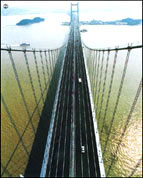




| Investments
Pave Way for Growth |

|
China has made tremendous achievements in fixed assets investments during the ninth Five-Year Plan period (1996-2000). The target for fixed assets investments was set at 13,000 billion yuan (US$1,566 billion), and based on the first four years' performance and estimates for the year 2000, this could easily be achieved. Adopting moderately tight fiscal policy, the government intended to control investment in order to tame runaway inflation at the beginning of the period. In 1997, the country's export volume, foreign investment and domestic demand all dramatically plunged because of the Asian financial crisis. To offset the negative impact of the crisis, the central government pursued proactive fiscal policies the following year, including issuing long-term building treasury bonds in a bid to attract bank loans and idle capital. The central government has rigorously controlled the use of funds raised by the bonds to avert unnecessary building. Central and western regions of China were given top priority in using the capital, and governments at all levels have paid close attention to improving the quality of the projects aided by the funds. The central government had invested 1,100 billion yuan (US$132.5 billion) by the end of 1999, and projects with a total investment of 2,200 billion yuan (US$265 billion) are index.htmcted to be completed by the end of 2001. Bonds contributed 1.5 percent to the gross domestic product (GDP) in 1998 and 2 percent in 1999, laying a solid foundation for hefty economic development in the new century. Water conservation and environment protection projects have drawn huge capital. Flood control works and water harnessing projects at the Yangtze River and Taihu Lake valley have considerably alleviated flood damage. Investment of 115 billion yuan (US$13.8 billion) has been injected into the areas. The Three Gorges project is well on track, and by the end of the year 2000, 65 billion yuan (US$7.8 billion) -- half of the total planned investment -- will have been put into it. In 2003, the first batch of generators will perform operations as scheduled. Investment in forests has also helped to improve the environment. By 1998, forest coverage across the country had increased by 2.6 percent to 16.55 percent since 1995. Railway and highway construction has also taken a large share. During the ninth Five-Year Plan period, 800 billion yuan (US$96.4 billion) was earmarked for road building, five times that of the previous five-year period. To date, 99 percent of the towns and 90 percent of the villages across the country have been connected up by roads. The total length of national railway is expected to reach 68,000 kilometers by the end of 2000, 6,000 kilometers longer than in 1995. Concerning electricity, the country will be able to generate 1,300 billion kilowatt-hours of electricity by the end of 2000, around 30 percent up from 1995. Upgrading grids and building nuclear power stations is also well under way. Public utilities in cities such as gas and water supply, transport and rubbish disposal have made rapid progress. Domestic properties have also improved and in 1999, the average housing area for each urban and township resident reached 9.3 square meters. Investment in education also soars. Up to 100 universities and colleges have been developed during the period, following the launch of the 211 projects. In 2000, 1.8 million students were admitted to universities and colleges. Emphasis has also been placed on developing schools in poverty-ridden areas in central and western parts of China. Upgrading technology and innovations will propel economic development forward. The technology upgrading program helps large- and medium-sized state-owned businesses to extricate themselves from difficulties. The nation aims to stimulate innovation in information and automatic technology, energy, transport and materials. During the ninth Five-Year period, the high-tech development zones have entered a new stage characterized by technology innovation. The zones have vigorously boosted the local economy with a high rate of return on investments. By the end of 1999, 17,000 high-tech businesses in the zones have contributed an industrial added value -- extra cash made in production industries -- of 147.6 billion yuan (US$17.8 billion), with an export volume worth US$12 billion. Reforming financial fields has helped China adapt to the socialist market economy. During the period, banks have been required to take all the risk in granting loans and the government no longer interferes in banks assessing and approving credit. The government has further regulated security investment and stepped up its issue of stocks and bonds to encourage companies to use the capital market and transform themselves into shareholding companies. The ninth Five-Year Plan period has also reinforced supervision over investment by governments at all levels. Since 1998, inspectors have been sent to examine projects -- especially those aided by treasury bonds -- to guarantee the government's investments are being properly used. Government purchase has also been regulated in the period. As the country has adopted a law for public bidding, any projects paid for out of national funds have to invite bidding from the public. (China Daily 10/03/2000) |